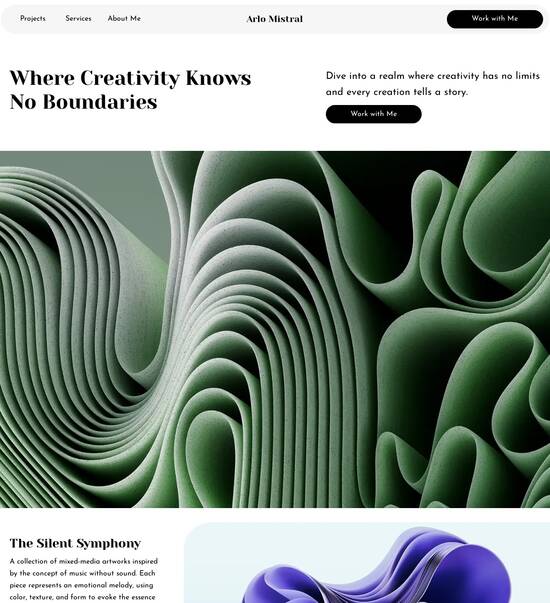
Next.js optimized maintenance page template
Explore Similar TemplatesAbout template
Supercharge your maintenance page with Next.js for outstanding performance! Learn more today.
Recommended templates

Easy to build without coding
With the intuitive drag-and-drop builder, anyone on your team can create high-converting pages without any knowledge of code or design. Make enhancements to your landing page with custom widgets using Javascript, HTML/CSS, or third-party scripts.

Multiple layouts for any industry and goal
Select from 500+ landing page layouts built to boost conversions across industry-specific scenarios. Customize them by adjusting fonts, adding images, and generating on-brand content with the AI assistant. Quickly scale with Instablocks® and Global Blocks that you can save, reuse, and update globally.

Loads fast and looks polished on any device
Every template is responsive, which means they present professionally on any device and load blazingly fast with our Thor Render Engine. You can also power them up with Google AMP technology to deliver an unparalleled mobile experience and drive higher conversions.

Robust analytics & experimentation
Get real-time updates and reporting across all your devices, showing the number of visitors, conversions, cost-per-visitor, and cost-per-lead. Launch AI-powered experiments, run A/B tests, and use heatmaps to analyze user behavior, then optimize your landing page to maximize conversions.







Easy to build without coding
With the intuitive drag-and-drop builder, anyone on your team can create high-converting pages without any knowledge of code or design. Make enhancements to your landing page with custom widgets using Javascript, HTML/CSS, or third-party scripts.
Multiple layouts for any industry and goal
Select from 500+ landing page layouts built to boost conversions across industry-specific scenarios. Customize them by adjusting fonts, adding images, and generating on-brand content with the AI assistant. Quickly scale with Instablocks® and Global Blocks that you can save, reuse, and update globally.
Loads fast and looks polished on any device
Every template is responsive, which means they present professionally on any device and load blazingly fast with our Thor Render Engine.
Robust analytics & experimentation
Get real-time updates and reporting across all your devices, showing the number of visitors, conversions, cost-per-visitor, and cost-per-lead. Launch AI-powered experiments, run A/B tests, and use heatmaps to analyze user behavior, then optimize your landing page to maximize conversions.
All the features you need to build nextjs maintenance mode
Explore more featuresLearn how to build nextjs maintenance page
Frequently asked questions about next js maintenance page
Leading the way in building high-performing landing pages





Maintenance page nextjs: Your ultimate how-to guide
In the digital marketing landscape, a powerful landing page is critical for achieving high conversion rates. Instapage’s capabilities empower marketers to design and optimize landing pages that resonate with diverse audiences. With features tailored for various industries, including tech/SaaS and government, Instapage stands out by integrating a range of tools right into one platform, ensuring an improved ROI for marketing campaigns.
Understanding the value of Instapage
Instapage is designed for ease of use while delivering robust functionality. It provides over 100 customizable templates that cater to different marketing strategies and industry requirements. Marketers can quickly launch pages without needing extensive design skills or coding knowledge, making it an ideal solution for businesses of all sizes. This flexibility allows users to maintain brand consistency while effectively reaching their target audiences.
- Diverse templates: Select from hundreds of pre-designed landing pages optimized for conversion rates.
- Ease of customization: Utilize intuitive drag-and-drop builders and pre-built lead generation elements tailored for your needs.
- Rapid deployment: Launch campaigns faster by minimizing design bottlenecks typically faced by marketing teams.
Optimizing landing pages for peak performance
Optimization is key to maximizing conversions. Instapage includes built-in A/B testing and analytics capabilities, allowing marketing teams to make informed adjustments.
- A/B testing: Assess different versions of landing pages to find which elements drive better results.
- Heatmaps: Use detailed heatmaps to visualize user interaction and make adjustments based on user behavior.
- Performance analysis: Track detailed metrics to understand the impact of changes and adapt strategies accordingly.
Personalizing experiences for distinct audiences
The power of personalization can’t be overstated in today’s marketing environment. Instapage's dynamic text replacement and AdMaps ensure messaging aligns perfectly with audience expectations.
- Dynamic experiences: Tailor content dynamically based on user data to enhance engagement.
- Ad alignment: Ensure continuity between ad messages and landing page content for better user experiences.
- Segmentation tracking: Monitor metrics by audience segment to refine messaging strategies.
The combination of these features positions Instapage as a leader in personalizing and optimizing landing pages, allowing marketers to max out their campaign potential.
In summary, Instapage provides a comprehensive toolkit for marketers, combining ease of use with advanced functionality to enhance every aspect of digital campaigns.
Get started with Instapage today to elevate your marketing strategy. Sign up for a demo and experience firsthand the power of optimized landing pages.
Next.js optimized maintenance page template
Understanding the context: The importance of maintenance pages in web development
Maintenance pages play a crucial role in the user experience of web applications. They notify users of temporary downtimes, ensuring that visitors are aware of any disruptions in service. This helps to manage user expectations and maintain trust in the online brand.
While the primary purpose of a maintenance page is to inform users, it also serves a distinct function from traditional error pages such as 404 or 500. Maintenance pages proactively communicate scheduled downtimes, whereas error pages indicate an unexpected issue that has arisen, which can often lead to frustration and confusion for users.
System updates and upgrades: Regular improvements or enhancements to the system often require temporary shutdowns.
Major feature rollouts: New features can necessitate downtime to integrate seamlessly into existing systems.
Unexpected server issues: When technical difficulties arise, maintenance pages keep users informed about the ongoing situation.
Next.js: A powerful framework for building modern web applications
Next.js offers a robust framework that simplifies the development of modern web applications. One of its standout features is server-side rendering, which allows web pages to be rendered on the server for faster load times and better user interactions. This is particularly beneficial for SEO, as search engines can easily crawl and index the content that is served directly from the server.
Additionally, Next.js supports static site generation and incremental static regeneration, allowing developers to build applications that can serve static content efficiently while still being able to update and manage dynamic content over time.
Built-in routing system: Next.js simplifies navigation through a file-based routing system, making it user-friendly for developers.
Seamless API integration: Developers can easily utilize APIs, enhancing the functionality of web applications.
Middleware complexities: Next.js supports middleware for advanced request handling, optimizing performance and enhancing user experiences.
The role of middleware in handling maintenance pages
Middleware is an essential component in Next.js that allows developers to manage and intercept requests, enabling the creation of customized maintenance pages. Utilizing middleware, developers can control user access to various parts of an application during scheduled downtimes, ensuring users are quickly redirected to informative maintenance pages.
Setting up middleware involves defining specific conditions under which requests are intercepted. This provides optimal control over how users interact with the website during maintenance periods, ensuring that the experience remains as seamless as possible.
Strategies for redirecting users: Setting conditions in middleware to divert users to a maintenance page.
Managing user experience: Providing a smooth transition to maintenance content can keep users informed and engaged without frustration.
Developing an optimized maintenance page template
When creating a maintenance page template, there are numerous design considerations to keep in mind. The importance of branding can’t be overstated, as users should recognize the identity of the company even during downtimes. Consistent branding reassures users that they are still interacting with the same trusted source.
Clarity is also key; the messaging on the maintenance page should be straightforward and informative. It’s critical to clearly communicate the reason for the downtime and provide an estimated duration if possible, helping to alleviate user concern.
Informative messaging: Clear communication about the nature and length of maintenance helps maintain user trust.
Estimated downtime indications: Users appreciate knowing when services are expected to resume.
Links back to home page and contact information: Easy navigation for users allows them to return to the main site or seek support.
Enhancing SEO during maintenance periods
When a site undergoes maintenance, it’s essential to keep search engine optimization (SEO) best practices in mind. Using the appropriate HTTP status codes, such as 503 for service unavailable, is crucial as it lets search engines know that the downtime is temporary. This practice ensures that they don’t penalize the site for being inaccessible.
Additionally, managing crawler access via the robots.txt file can prevent search engines from crawling the maintenance page, which might otherwise lead to indexing issues post-maintenance. This proactive approach minimizes SEO impact, allowing the website to recover its ranking once operations resume.
Right HTTP status codes: Communicating the temporary nature of the maintenance helps maintain SEO standing.
Robots.txt rules: Control search engine access to minimize potential pitfalls during downtimes.
User experience: Balancing needs during downtimes
User expectations during maintenance periods can vary widely. Many users appreciate being informed about what’s happening and how it affects their ability to access the site. By emphasizing transparency and communication through maintenance pages, businesses can foster a sense of trust even when services are temporarily unavailable.
Understanding emotional responses to maintenance communications versus error messages is vital. Maintenance pages can be framed in a way that sets expectations positively, in contrast to the often alarming notifications associated with 404 or 500 error pages.
Alternative resources or support links: Keeping users engaged is essential, so providing alternatives is helpful.
Notifications for when maintenance is scheduled: Advanced notice can mitigate user dissatisfaction.
Implementation best practices in Next.js
Building a maintenance page in Next.js involves careful planning and execution. One effective approach to implementation is through setting up middleware that dynamically handles route management. This ensures that users are automatically redirected to the maintenance page during specified downtimes.
Creating a visually appealing layout using CSS Modules can significantly enhance user experience. Designers should prioritize mobile responsiveness and intuitive navigation. Leveraging APIs to fetch real-time updates on maintenance status can ensure that users are always informed about the current state of the site.
Setting up middleware for dynamic route handling: Ensures users are redirected efficiently.
Crafting the visual layout and UI elements with CSS Modules: Enhances the overall appearance and user experience.
Utilizing an API for real-time updates on maintenance periods: Keeps users informed and reduces anxiety.
Real-world examples and case studies
There are several examples of successful implementations of maintenance pages in Next.js that provide valuable insights. High-traffic websites, particularly during major updates, have developed informative and branded maintenance pages that reassure users about their service commitment. These examples demonstrate effective communication strategies that prevent frustration during downtime.
Conversely, examining failures can also provide important lessons. Instances where websites employed vague or poor communication strategies resulted in user dissatisfaction and dropped engagement rates. Key takeaways from these failures emphasize carving out clear, informative messaging is essential.
Successful implementations: High-traffic sites effectively manage user expectations during updates.
Lessons learned from failures: Poor communication strategies can lead to user frustration.
Future trends and innovations in maintenance page design
The landscape of maintenance page design is constantly evolving. Predictive maintenance utilizing AI and machine learning technology is poised to enhance how businesses manage downtimes. By analyzing user patterns, businesses can foresee potential maintenance periods and alert users promptly. Automated notifications can keep users updated during scheduled maintenance, thereby enhancing the overall experience.
Additionally, as Progressive Web Apps (PWAs) gain traction, integrating offline functionalities into maintenance pages can significantly enhance user experience. Users may still access certain features or content during downtimes, making the wait less tedious and more productive.
Predictive maintenance: Using technology to foresee downtimes can improve communication with users.
PWAs and offline functionalities: Providing users with access to certain features during maintenance can improve retention.
Conclusion: The bright side of downtime
Crafting an effective maintenance page is more than just aesthetic; it’s about value communication. A well-designed maintenance page enhances trust and user experience, allowing businesses to manage downtimes gracefully. Through continuous improvements and a commitment to transparent communications, web applications can navigate the challenges of maintenance periods efficiently.
Ultimately, how a business handles maintenance impacts user loyalty and brand perception. Therefore, investing in a well-optimized maintenance page template built on Next.js is a strategic move that can yield significant long-term benefits.
Ready to skyrocket conversions?
Supercharge your ad campaigns with high-performing landing pages
Get started














